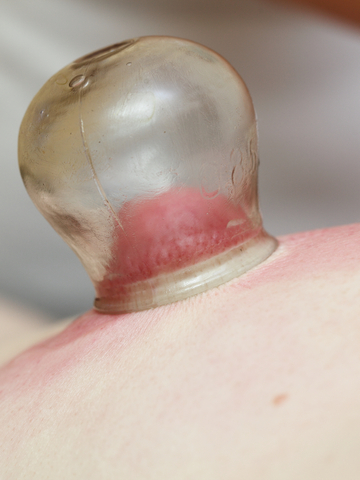Let’s start with a quiz:
A. Cupping is an exotic cooking term from Thailand.
B. Cupping is men’s attempts to protect their private parts.
C. Cupping is an ancient technique that involves using cups on the skin, creating suction to enhance circulation, relieve pain, and provide many other benefits.
Correct answer: C (I really hope you got that right, but if not, this article is a chance to learn more).
I remember when cupping therapy was relatively unknown in the US, but during the last few years, cupping has become increasingly popular. I definitely have more people in my Chicago office requesting to try it and reaping the benefits. I’ll admit, some of the rise in popularity is due to the many celebrities and athletes who use cupping therapy and show off their unique round marks to the press.
Believe it not, Gwyneth didn’t develop cupping. Cupping is thousands of years old and it is not exclusive to the Chinese. Variations of cupping therapy have been used by ancient Egyptians and in other African countries, by North American Indians, by early Greeks, and in other parts of Asia and Europe. One of the oldest medical textbooks in the world, the Ebers Papyrus, describes how ancient Egyptians used cupping therapy in 1,550 B.C.. WOW!
Cupping is based on simple ideas. Specially made glass, bamboo or plastic jars are placed on the patient’s skin to create suction. Traditionally this was done with fire, but in the more modern version, a hand pump is used to create the vacuum inside the cup. This action causes the underlying tissue to be sucked partway into the cup, how much depends on the amount of suction used. You will probably feel a tight sensation in the area of the cup, that often feels good and relaxes aching muscles. If it is too tight let your practioner know so they can adjust the amount of suction to your comfort.
After I remove the cups, everyone talks about feeling a release of tension and tightness – it feels great!
Cupping is also the type of treatment from which almost everyone benefits. The exceptions are sensible; Cupping therapy is not for pregnant women and patients who bleed easily and/or cannot stop bleeding. In addition, cups should not be applied to areas of the body with skin ulcers, edema, infection or large blood vessels. Everyone else, enjoy!
Cups can be applied for a very short period of time (30 seconds – 1 minute) or left in place for 20 minutes. This depends on the patient, the presenting condition to be treated, and of course, your practitioner’s judgement.
The purpose of cupping is to enhance circulation, help relieve pain, and pull toxins from your body’s tissue. It often gets good results for patients who suffer from chronic fatigue syndrome, flu, colds, back pain, coughs, allergies, muscle pain, fevers, bronchial congestion, arthritis and anxiety.
If you have seen the photos of “celebs who cup”, you already know that cupping may cause your skin to temporarily turn red, blue or purple. The skin discoloration can last anywhere from a few days to a couple of weeks. In the warm weather, when more skin is exposed, it will be a conversation starter. You may also experience some mild soreness, but don’t worry, this is normal.
In my Chicago practice, I always recommend that my patients take an epsom bath after a cupping session (use at least 2 cups of epsom salt). These salts are anti-inflammatory and can relieve potential discomfort while enhancing the benefits. You will feel looser and enjoy the relief from tense muscles. It is easy to understand why cupping has lasted for centuries and is now sucking in (pun intended) people all over the world.



Comments 4
This is a great article!
Author
Thank you!
Pingback: Cupping Only Sessions Will be $70 Starting March 1st. - Jennifer Dubowsky, DIPL.Ac.
Pingback: What Are Allergies And How Can Acupuncture Help? - Jennifer Dubowsky, DIPL.Ac.